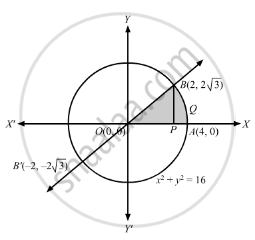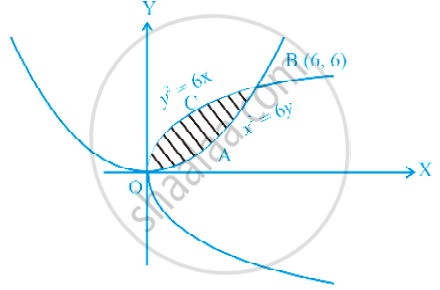Advertisements
Advertisements
प्रश्न
Find the area of the region in the first quadrant enclosed by x-axis, the line y = \[\sqrt{3}x\] and the circle x2 + y2 = 16.
उत्तर

\[ \Rightarrow x^2 + \left( \sqrt{3} x \right)^2 = 16\]
\[ \Rightarrow 4 x^2 = 16 \]
\[ \Rightarrow x = \pm 2\]
\[ \Rightarrow y = \pm 2\sqrt{3}\]
\[B\left( 2 , 2\sqrt{3} \right)\text{ and }B'\left( - 2 , - 2\sqrt{3} \right) \text{ are points of intersection of circle and straight line }\]
\[\text{ Shaded area }\left( OBQAO \right) =\text{ area }\left( OBPO \right) +\text{ area }\left( PBQAP \right)\]
\[ = \int_0^2 \sqrt{3} x dx + \int_2^4 \sqrt{16 - x^2} dx\]
\[ = \sqrt{3} \left[ \frac{x^2}{2} \right]_0^2 + \left[ \frac{1}{2}x\sqrt{16 - x^2} + \frac{16}{2} \sin^{- 1} \left( \frac{x}{4} \right) \right]_2^4 \]
\[ = 2\sqrt{3} + 8 \times \frac{\pi}{2} - 2\sqrt{3} - 8 \times \frac{\pi}{6}\]
\[ = 2\sqrt{3} + 4\pi - 2\sqrt{3} - \frac{4\pi}{3}\]
\[ = \frac{8\pi}{3}\text{ sq units }\]
\[\text{ Area bound by the circle and straight line above }x\text{ axis }= 2\sqrt{3} + \left( - 2\sqrt{3} + 8 \times \frac{2\pi}{6} \right) = \frac{8\pi}{3}\text{ sq units }\]
APPEARS IN
संबंधित प्रश्न
Find the area of the region bounded by the parabola y2 = 4ax and its latus rectum.
Find the area of the region bounded by the parabola y2 = 16x and the line x = 3.
Find the area of the sector of a circle bounded by the circle x2 + y2 = 16 and the line y = x in the ftrst quadrant.
Sketch the region bounded by the curves `y=sqrt(5-x^2)` and y=|x-1| and find its area using integration.
Sketch the region {(x, y) : 9x2 + 4y2 = 36} and find the area of the region enclosed by it, using integration.
Determine the area under the curve y = \[\sqrt{a^2 - x^2}\] included between the lines x = 0 and x = a.
Show that the areas under the curves y = sin x and y = sin 2x between x = 0 and x =\[\frac{\pi}{3}\] are in the ratio 2 : 3.
Compare the areas under the curves y = cos2 x and y = sin2 x between x = 0 and x = π.
Find the area bounded by the curve y = 4 − x2 and the lines y = 0, y = 3.
Draw a rough sketch and find the area of the region bounded by the two parabolas y2 = 4x and x2 = 4y by using methods of integration.
Find the area common to the circle x2 + y2 = 16 a2 and the parabola y2 = 6 ax.
OR
Find the area of the region {(x, y) : y2 ≤ 6ax} and {(x, y) : x2 + y2 ≤ 16a2}.
Find the area of the region bounded by the parabola y2 = 2x + 1 and the line x − y − 1 = 0.
Using integration, find the area of the triangle ABC coordinates of whose vertices are A (4, 1), B (6, 6) and C (8, 4).
Find the area of the region bounded by the curve y = \[\sqrt{1 - x^2}\], line y = x and the positive x-axis.
Find the area bounded by the lines y = 4x + 5, y = 5 − x and 4y = x + 5.
If the area bounded by the parabola \[y^2 = 4ax\] and the line y = mx is \[\frac{a^2}{12}\] sq. units, then using integration, find the value of m.
Find the area of the region between the parabola x = 4y − y2 and the line x = 2y − 3.
The area bounded by the curve y = loge x and x-axis and the straight line x = e is ___________ .
The area of the region bounded by the parabola y = x2 + 1 and the straight line x + y = 3 is given by
Smaller area enclosed by the circle x2 + y2 = 4 and the line x + y = 2 is
Find the coordinates of a point of the parabola y = x2 + 7x + 2 which is closest to the straight line y = 3x − 3.
Find the area of the region bound by the curves y = 6x – x2 and y = x2 – 2x
Using the method of integration, find the area of the region bounded by the lines 3x − 2y + 1 = 0, 2x + 3y − 21 = 0 and x − 5y + 9 = 0
Using integration, find the area of the smaller region bounded by the ellipse `"x"^2/9+"y"^2/4=1`and the line `"x"/3+"y"/2=1.`
Find the area of the region bounded by the parabolas y2 = 6x and x2 = 6y.
The area of the region bounded by the curve x = y2, y-axis and the line y = 3 and y = 4 is ______.
Find the area of the region bounded by the curves y2 = 9x, y = 3x
Find the area of the region bounded by the curve y = x3 and y = x + 6 and x = 0
Compute the area bounded by the lines x + 2y = 2, y – x = 1 and 2x + y = 7.
The area of the region bounded by the circle x2 + y2 = 1 is ______.
The area of the region bounded by the curve x = 2y + 3 and the y lines. y = 1 and y = –1 is ______.
Using integration, find the area of the region in the first quadrant enclosed by the line x + y = 2, the parabola y2 = x and the x-axis.
If a and c are positive real numbers and the ellipse `x^2/(4c^2) + y^2/c^2` = 1 has four distinct points in common with the circle `x^2 + y^2 = 9a^2`, then
The region bounded by the curves `x = 1/2, x = 2, y = log x` and `y = 2^x`, then the area of this region, is
Find the area of the region bounded by the curve `y^2 - x` and the line `x` = 1, `x` = 4 and the `x`-axis.
Find the area of the region bounded by the curve `y = x^2 + 2, y = x, x = 0` and `x = 3`
The area bounded by the curve `y = x|x|`, `x`-axis and the ordinate `x` = – 1 and `x` = 1 is given by
Let the curve y = y(x) be the solution of the differential equation, `("dy")/("d"x) = 2(x + 1)`. If the numerical value of area bounded by the curve y = y(x) and x-axis is `(4sqrt(8))/3`, then the value of y(1) is equal to ______.
Let f(x) be a non-negative continuous function such that the area bounded by the curve y = f(x), x-axis and the ordinates x = `π/4` and x = `β > π/4` is `(βsinβ + π/4 cos β + sqrt(2)β)`. Then `f(π/2)` is ______.
